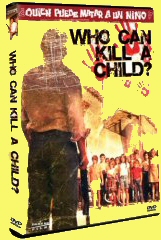
Perhaps the worst possibility imaginable (even in today's morally bankrupt culture) is the needless suffering of a child. This idea and the emotional/mental associations connected to it are so very strong -- and evoke such frenzied reaction -- that even the horror genre usually skips around the idea, afraid to face the realism of child abuse and death. The last taboo in a culture more and more willing to cross lines of status quo taste, this theme remains largely unexplored in both fiction and media. While this is understandable on a surface level, suggesting the reverence we claim to have for children, on an aesthetic level we do a disservice to both our subject and children by pretending that the young do not indeed suffer -- most often due to the conflicts, idiocy, and bloodthirsty desires of adults. This idea and its social and emotional ramifications are leading forces behind one of the more serious minded exploitation films of the 1970s-- a movie that embraced the knowledge that the genre should not only provoke and shock but challenge. Who Can Kill A Child? (1976) stares directly into the dark heart of our worst fears, emphasizing the carnage that adults the world over commit towards the young through politics and social norms. At the same time, the plot supports the violence committed by the two 'heroes' against children, creating an artful, poignant tension and sense of contradiction between surface plot ands theme.
Two British citizens -- Tom (Lewis Flander) and his pregnant wife Evelyn (Prunella Ransome) -- are on vacation and take a trip to an obscure fishing Island somewhere off Spain's coast. Arriving, they notice that, aside from children, the town appears deserted. Tension mounts as the\y search for adults or figures of authority. Telling themselves that there must be a fiesta or some other celebration, suspense turns into terror as haunted glimpses of misplaced children and isolation increase. Normality is shattered when they discover and old man being beaten by a group of children. As Tom and Evelyn run across more instance of like brutality, it becomes apparent that these kids aren't your normal nose-picking little angels. When they discover an adult hiding in an attic room, they learn that the town's children, as though programmed, have turned on the adults. Families, unwilling to hurt their offspring, were massacred. When the children begin to surround them, Tom and Evelyn must make their own choice: be slaughtered or kill a child.
The plot to this darkly poetic, gut-wrenching exercise borrows from the survival/siege genre and the long line of 'bad children' films, going beyond their typical simplistic moral sense of good and bad by presenting the struggle for survival between the children and luckless adults in shades of ambiguity and amorality. While Bad Children were hardly a new image in the Seventies, having seen the screen in such films as Bad Seed, It's A Good Life, and Village of the Damned, none of these films, coated in their status quo muck of clearly defined parameters of 'right' and/or 'wrong' dared explore the very real conflict between generations. Director Narcisco Ibáñez-Serrador presents a sun-backed nightmare without shying away from either the violence or allegorical complexity of the situation. Meshing dark fantasy and realism, his direction and mood gives the story the ambience of surrealism. Yet fantasy is subdued by his insistence to focus clearly and honestly on modern nihilistic violence, ensuring that we understand the full grim horror of the situation. It could be said that Serrador was too successful in making audiences squirm, for this shocking and thoughtful masterwork of subversive art, despite its visual and thematic excellence, has been criminally neglected -- not only by ho-hum mainstream culture (which posses all the intellect of a cucumber) but also by the genre that it raises to the level of art. The explicit moroseness and unabashed amorality of the context (and action) of the story asks too much from an age weaned on false illusions of moral righteousness and sterile entertainment, following its depressing premise to a satisfyingly grim conclusion. This isn't safe, sane storytelling, kiddies. No, this is in-your-face artistic terrorism.
Released with severe cuts in the US as Island of the Damned, this marks the first time that Who Can Kill A Child? Has been given a DVD release Stateside. Dark Sky Films presents this intelligent, disquieting cinematic attack unedited and uncensored, with all the nastiness intact. The picture is in anamorphic 1.85:1. The transfer is nearly impeccable, with very minor grain and one or two instances of scratching. Besides this, the visual elements look superb, with fresh, bleeding colors and crisp image detail. Audio features both a track combining English and Spanish and the original Spanish (with subtitles). While both are clean and enjoyable to listen to, the edge belongs to the mixed track, further suggesting the lack of communication between the adults and the children, and by extension between the generations. Both lend to atmosphere and tone. Extras are insightful and rewarding, devoted to establishing a context for the film and personalities behind it rather than simply languishing in self congratulations. These include a generous Gallery of Stills and Art, and, more significantly, two interview featurettes produced by David Gregory, a fellow who consistently turns out engaging and intelligent discussions with the genre's most interesting personalities. Barcelona native Miguel F. Graciani conducts the interviews, in Spanish. Cameraman José Luis Alcaine describes the various locations utilized in the film, describing how "Almanzora" was spread all over Spain. The second interview features director Serrador, whose ill health doesn't prevent him from coming across as both intelligent and sincere.
Review by William Simmons
| Released by Dark Sky |
| Region 1 - NTSC |
| Not Rated |
| Extras : |
| see main review |